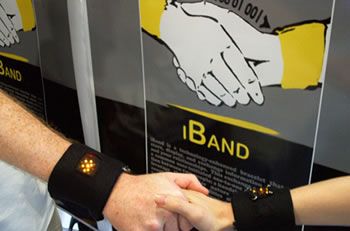Wrist-y Business: The iBand Data Exchange Bracelet

As the makers of the new iBand remark, initial meetings and introductions build relationships, but only if you can remember whom you shook hands with. That's why the iBand gathers and processes information automatically when it registers a handshake with someone wearing another unit.
Put 'er there, pal. iBand gives new meaning to "cootie" transfer.
The prototype is a wearable bracelet, adjustable in design for different kinds of users (male, female). When worn, the circuit board and battery lay flat under the wrist and an infrared (IR) transceiver is positioned near the back of the thumb pointing toward the hand such that it is visible to an IR transceiver on another device when shaking hands. A handshake is detected via infrared transceiver alignment combined with hand/wrist orientation and gesture recognition using a 2-axis accelerometer.
I love the fact that the iBand has an actual handshake-recognition engine. However, in my long history of playing pick-up basketball (back in the day), I seem to remember a large number of variations on the simple handshake. I find myself wondering if the iBand can be programmed for hand jive recognition (HJR).
Science fiction fans recall that in the virtual world of Neal Stephenson's Snow Crash , avatars could exchange encyclopedic quantities of data in a similarly businesslike manner by exchanging their hypercards, which were high tech business cards packed with data. If you are interested in getting ahead in relationships or business politics, you might want to check out the personality simulator from The Dosadi Experiment , a great Frank Herbert novel. This piece of technovelgy predated The Sims by a decade.
(This Science Fiction in the News story used with permission from Technovelgy.com - where science meets fiction .)
Sign up for the Live Science daily newsletter now
Get the world’s most fascinating discoveries delivered straight to your inbox.











